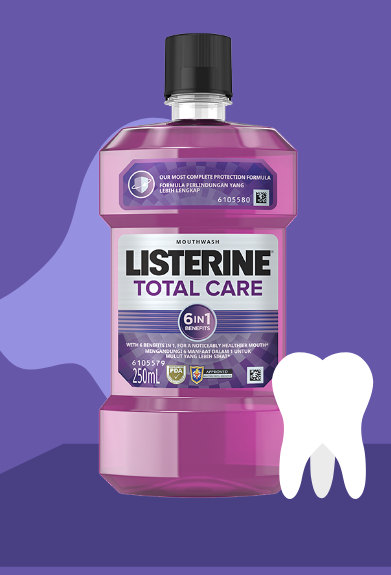This content is intended for Healthcare Professionals only.
It is a source of continuing educational content for you and your patients. You must not use the content for any other purpose. By clicking ‘yes’ below you are agreeing that you are a registered dental healthcare professional with a current license number and are entitled to access this content. Your use of this content is also subject to our “Terms of Use” and “Privacy Policy”.
SAFE FOR BOTH DAILY AND LONG-TERM USE
- Does not promote oral dryness2-4
- Does not disrupt the normal balance of oral flora3,4
- No emergence of resistant strains, even with long-term use3,4
- Does not promote significant tooth stain or calculus (tartar) formation5-8
ALCOHOL-CONTAINING RINSES HAVE NO CAUSAL LINK TO ORAL DRYNESS
In clinical trials:
- Safe for xerostomic patients2
- Favorable tolerability, no drying of oral mucosa, and no decreased salivary flow rates2
- No significant differences in salivary flow rates or patient-reported sensations of dry mouth between alcohol and non-alcohol-containing mouthrinse groups3
- Alcohol-based essential oil mouthrinse no more likely to cause a reduction in salivary flow or perceived dryness than a non-alcohol-based cetylpyridinium chloride (CPC) mouthrinse4
ALCOHOL-CONTAINING RINSES HAVE NO LINK TO ORAL CANCER
In clinical trials:
- No credible link to oral cancer5-8
- An FDA subcommittee reviewed 7 case-control studies and concluded: “Data do not support a causal relationship between the use of alcohol-containing mouthrinses and oral cancer. The vote was unanimous…”5
- Alcohol-containing mouthwash does not increase risk of oropharyngeal cancer6
- Link between mouthwash use (specifically alcohol-containing mouthwash) and oral cancer is not supported by epidemiological evidence7
- No association between use of mouthwash containing alcohol and oral cancer risk8
*Based on self-reported data from a survey of patients in Brazil, Japan, Thailand, United Kingdom, and United States (N=4134).
References: 1. Data on file, Johnson & Johnson Consumer Inc. 2. Fischman SL, Aguirre A, Charles CH. Use of essential oil-containing mouthrinses by xerostomic individuals: determination of potential for oral mucosal irritation. Am J Dent. 2004;17(1):23-26. 3. Kerr AR, Katz RW, Ship JA. A comparison of the effects of 2 commercially available nonprescription mouthrinses on salivary flow rates and xerostomia. Quintessence Int. 2007;38(8):e440-447. 4. Kerr AR, Corby PM, Kalliontzi K, McGuire JA, Charles CA. Comparison of two mouthrinses in relation to salivary flow and perceived dryness. Oral Surg Oral Med Oral Pathol Oral Radiol. 2015;119(1):59-64. 5. Food and Drug Administration. Oral health care drug products for over-the-counter human use; antigingivitis/antiplaque drug products; establishment of a monograph; proposed rules. Part III. Federal Register. 2003;68(103):32232-32287. 6. Cole P, Rodu B, Mathisen A. Alcohol-containing mouthwash and oropharyngeal cancer: a review of the epidemiology. J Am Dent Assoc. 2003;134(8):1079-1087. 7. La Vecchia C. Mouthwash and oral cancer risk: an update. Oral Oncol. 2009;45(3):198-200. 8. Boyle P, Gandini S, Boffetta P, Negri E, La Vecchia C. Mouthwash use and oral cancer risk: quantitative meta-analysis of epidemiologic studies. Oral Surg Oral Med Oral Pathol Oral Radiol Endod. 2011;112(6):e130.
Featured Product in this Article:



All Fields required, unless otherwise indicated
Will be used as your user name
By submitting your information above, you agree that the information you provide will be governed by our site's Privacy Policy.